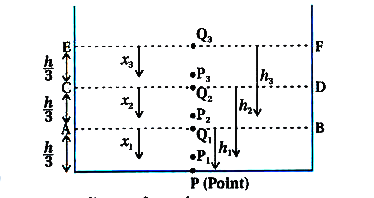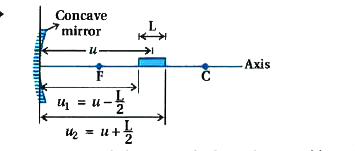Three immiscible liquids of densities d1>d2>d3 and refractive indies μ1>μ2>μ3 are put in a beaker. The light of each liquid column is h3. A dot is made at the bottom of the beaker. For near normal vision, find the apparent depth of the dot.
 Solution in Gujrati
Solution in Gujrati
⇒ According to formula,
Virtual depth =Real depthRefractive index of denser medium w.r.t rarer medium .....(1)
⇒ From equation (i)
(i) For first medium :
x1=h1(μ1μ2)=μ2μ1(h3)(∵h1=h3).........(2)
(ii) For second medium :
x2=h2(μ2μ3)
⇒ From figure h2=h3+x1
∴x2=h3+x1μ1m3=μ3μ2{h3+(μ2μ1×h3)}.......(3)
[ From equation (2)]
(iii) For the third medium
x3=h3(μ31)
⇒ Thus, from figure h3=h3×x2
x3=(h3+x2)μ3
=1μ3[h2+μ3μ2{h3+(μ2μ1×h3)}]
[From equation (3)]
=1μ3(h3)+1μ2{h3+(μ2μ1×h3)}
=1μ3(h3)+1μ2(h3)+1μ1(h3)
∴x3=h3(1μ1+1μ2+1m3)
Topper's Solved these Questions
- BOOK - KUMAR PRAKASHANCHAPTER - RAY OPTICS AND OPTICAL INSTRUMENTSEXERCISE - SECTION-C (NCERT EXEMPLAR SOLUTION) (SHORT ANSWER TYPE QUESITONS)6videos
RAY OPTICS AND OPTICAL INSTRUMENTS
- BOOK - KUMAR PRAKASHANCHAPTER - RAY OPTICS AND OPTICAL INSTRUMENTSEXERCISE - SECTION-C (NCERT EXEMPLAR SOLUTION) (LONG ANSWER TYPE QUESITONS)5videos
RAY OPTICS AND OPTICAL INSTRUMENTS
- BOOK - KUMAR PRAKASHANCHAPTER - RAY OPTICS AND OPTICAL INSTRUMENTSEXERCISE - SECTION-C (NCERT EXEMPLAR SOLUTION) (MULTIPLE CHOICE QUESTIONS (MCQs))16videos
RAY OPTICS AND OPTICAL INSTRUMENTS
- BOOK - KUMAR PRAKASHANCHAPTER - MOVING CHARGES AND MAGNETISMEXERCISE - SECTION D (MCQs ASKED IN COMPETITIVE EXAMS)34videos
MOVING CHARGES AND MAGNETISM
- BOOK - KUMAR PRAKASHANCHAPTER - SAMPLE QUESTION PAPER EXERCISE - PART-B SECTION-C5videos
SAMPLE QUESTION PAPER
Similar Questions
A short object of length L is placed along the principal axis of a concave mirror away from focus. The object distance is u. If the mirror has a focal length f, what will be the length of the image ? You may take L<<|v−f|.
 01:34View Solution
01:34View SolutionShow that for a material with refractive index μ≥√2~ , light incident at any angle shall be guided along a length perpendicular to the incident face.
03:13View SolutionA ray of light incident at an angle θ on a refracting face of a prism emerges from the other face normally. If the angle of the prism is 5∘ and the prism is made of a material of refractive index 1.5, the angle of incidence is
02:43View SolutionElectric charge Q having mass M moves on a circular path of radius R with velocity →v, perpendicular to uniform magnetic field B. When a particle completes one revolution, work done by the field is _______
04:08View SolutionTwo charges –q and +q are located at points (0, 0, –a) and (0, 0, a), respectively.
(a) What is the electrostatic potential at the points (0, 0, z) and (x, y, 0) ?
(b) Obtain the dependence of potential on the distance r of a point from the origin when r/a>>1 .
(c) How much work is done in moving a small test charge from the point (5,0,0) to (–7,0,0) along the x-axis? Does the answer change if the path of the test charge between the same points is not along the x-axis?04:00View SolutionPath of ray of light passing through three liquids of refractive indices μ1,μ2,μ3 is as shown in Fig. Which liquid has the smallest index of refraction ?
 .04:12View Solution
.04:12View SolutionThree immiscible liquids of densities d_1 gt d_2 gt d_3 and refractive indices mu_1 gt mu_2 gt mu_3 are put in a beaker. The height of each liquid column is (h)/(3) . A dot is made at the bottom of the beaker. For near normal vision, find the apparent depth of the dot.
03:13View SolutionA vessel of depth d is half filled with a liquid of refractive index μ1 and the other half is filled with a liquid of refractive index μ2. The apparent depth of the vessel, when looked at normally, is
03:28View Solutionदो अमिश्रणीय द्रव जिनके अपवर्तनांक μ1 औरμ2 हैं, एक बीकर में रखे गये हैं। यदि पहले और दूसरे द्रव की गहराइयाँ क्रमश: h1 व h2 हो, तो बीकर की तली में अंकित चिन्ह की आभासी गहराई क्या होगी?
04:32View Solutionएक बीकर की गहराई 10 सेमी है। इसका आधा भाग 1.4 अपवर्तनांक वाले द्रव से तथा शेष आधा भाग 1.7 अपवर्तनांक वाले द्रव से भरा है । यदि दोनों द्रव अमिश्रणीय हों तो उसकी तली पर रखे एक सिक्के की आभासी गहराई क्या होगी?
02:46View SolutionA double convex lens, made from a material of refractive index mu_1 , is immersed in a liquid of refractive index mu_2 , where mu_2 gt mu_1 . What change, if any, would occur in the nature of the lens?
04:35View SolutionThree immiscible liquids of densities d_1 gt d_2 gt d_3 and refractive indices mu_1 gt mu_2 gt mu_3 are put in a beaker. The height of each liquid is h/3 . A dot is made at the bottom of the beaker. For near normal vision, find the apparent depth of the dot.
04:23View Solutiond1>d2>d3 घनत्व के एवं μ1>μ2>μ3अपवर्तनांकों के तीन अभिश्रणीय द्रव एक बीकर में रखे हैं। प्रत्येक द्रव स्तंभ की ऊँचाई h/3 है। बीकर की तली में एक बिंदु (Dot) लगा है। सामान्य दृष्टि के लिए, बिन्दु (Dot) की आभासी गहराई क्या होगी?
View SolutionThree immiscible liquids of densities d1>d2>d3 and refractive indices μ1>μ2>μ3 are put in a beaker. The height of each liquid column is h3. A dot is made at the bottom of the beaker. For near normal vision, find the apparent depth of the dot.
04:25View SolutionA mark at the bottom of a liquid beaker appears to rise by 0.1 m. If the depth of the liquid is 1.0 m, then refractive index of the liquid is ......
02:02View Solution

